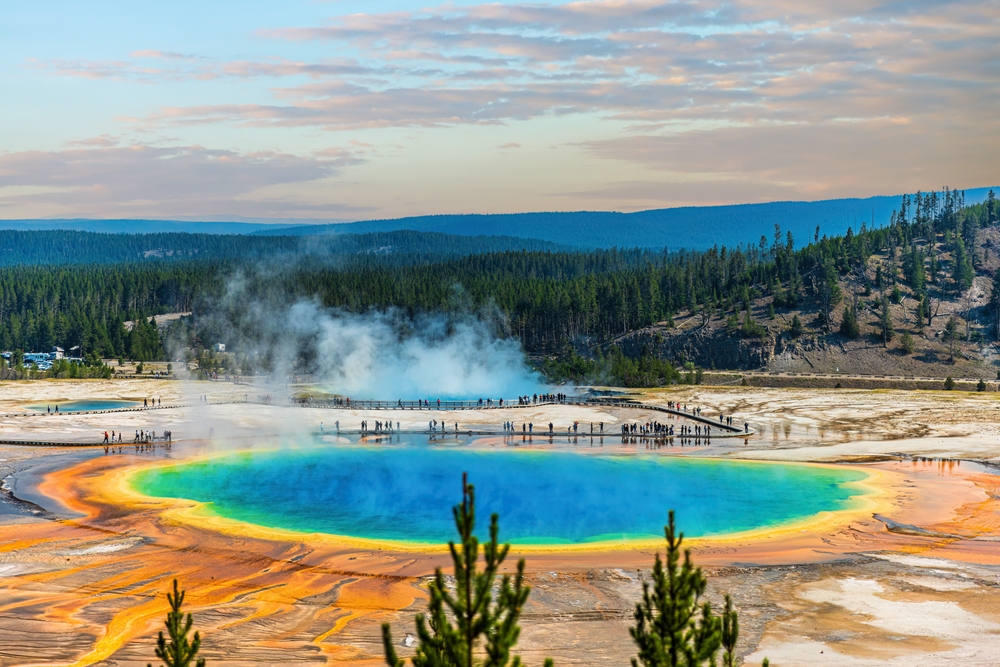Magma Beneath Yellowstone Appears to be on the Move
Rangers at Yellowstone National Park are often asked to predict when the next massive volcanic eruption will occur there.A team of USGS scientists, who surveyed the parks underground magma reservoirs, recently confirmed the standard response, probably not any time soon. But they have pointed out that the area where such activity is likely to occur has shifted, according to a report in the journal Nature.Reservoirs of Molton RockIts not like theres been a pattern of frequent, massive eruptions there; the area has seen only three major events over the past two million years. Those events are labeled caldera forming, because the molten rock vacating the underground reservoirs leaves an empty space, which leads to the land above collapsing, ultimately forming a bowl-shaped basin.Beneath those basins, called calderas, sit reservoirs of magma. The recent survey shows that the magma within them has not stood still. It now appears to be shifting to the northeast of the Yellowstone Caldera. For the past 160,000 or so years, the magma reservoirs have mainly existed beneath the caldera.However, a number of geologic factors suggest that, despite the movement, the reservoirs are not eruptible, according to the paper. That doesnt necessarily mean that the region will be completely devoid of volcanic activity just that it wouldnt be as cataclysmically explosive as the previous Big Three.Mapping the MagmaYellowstone is a destination largely because of volcanic activity. The hot liquid rock beneath the crust fuels the geysers, hot springs, and boiling mud pots that attract swarms of tourists to that corner of Wyoming. So how did the geologists come to their conclusion? First, not all magma is created equally. It is formed from different kinds of melted rock. Some contain more silica, some hold more basalt. Some is rich in minerals like iron or magnesium, some less so.These differences are important for two reasons. First, these different mineral mixes give off a variety of magnetic and electrical fields which geologists can measure. Thats exactly what the USGS scientists did essentially mapping the magma reservoirs throughout the Yellowstone Caldera area.The differences also give hints about how fast the magma flows, based on its mineral composition. For example, the magma nearest the surface of the Yellowstone Caldera contains a lot of silica, which lends the molten rocks a sticky, viscous, and slow-moving quality.Seven ReservoirsThe geologists magma-mapping efforts revealed seven distinct regions. Some reservoirs feed into each other kind of like the Great Lakes. They lie between 2.5 miles to 30 miles underground. They were perhaps most surprised by the northeast pocket both due to its location and composition. Earlier estimates had not placed this area as a potential producer of volcanic activity. The magma also is layered like a parfait, with two flavors. The lower level is rich in basalt, while the upper level contains a lot of silica. The lower level essentially helps keep the upper level warm.The upper-level chambers of silica-rich molten rock measure between 240 cubic miles to 300 cubic miles. Thats a lot of magma. Indeed, it is comparable to the amounts that were likely emitted during each of the previous three large eruptions.What are the Odds for Eruption?However, that magma is not likely to go anywhere anytime soon, wrote Mark Stelton, a USGS scientist stationed at the Yellowstone Volcano Observatory, in an online column called Caldera Chronicles.Stelton wrote that the short-term chance of an eruption is akin to the probability of getting bonked in the head by a baseball while standing outside a major league stadium. Predicting the frequency of a major Yellowstone eruption requires factoring how often such events happen within a given time period.Based on our current knowledge of Yellowstones eruptive history, the annual probability of a volcanic eruption is on the order of 0.001 percent, but even this low number is probably an overestimate for the short term, Stelton wrote in the column. There are no signs of an impending volcanic eruption based on monitoring data, and we know that the magmatic system beneath Yellowstone is mostly solid.Article Sources:Our writers at Discovermagazine.com use peer-reviewed studies and high-quality sources for our articles, and our editors review for scientific accuracy and editorial standards. Review the sources used below for this article:Before joining Discover Magazine, Paul spent over 20 years as a science journalist, specializing in U.S. life science policy and global scientific career issues. He began his career in newspapers, but switched to scientific magazines. His work has appeared in publications including Science News, Science, Nature, and Scientific American.


